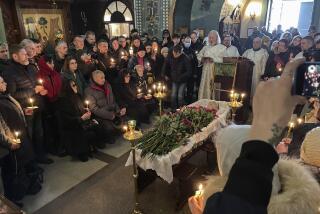Ukraine Church Controversy Outlives Patriarch : Europe: Dispute consigns religious leader to burial place in sidewalk while factions argue.
- Share via
KIEV, Ukraine — He spent two decades in Soviet prison camps and two years in Canadian exile, and even in death Ukrainian Orthodox Patriarch Volodymyr Romaniuk has no resting place.
The question of where to bury the patriarch, whose earthly remains are now stashed in a makeshift sidewalk grave, has triggered a religious and political storm that has pitted church leaders and nationalist politicians against President Leonid D. Kuchma.
Kuchma’s government suggests that the appropriate resting place for the controversial religious leader, one of two rival Ukrainian pontiffs, is the Kiev central cemetery.
Volodymyr’s deputy, the Metropolitan Filaret, said the patriarch must be buried inside the walls of St. Sophia Cathedral, Ukraine’s oldest and grandest church--and now a national monument.
“Either he will be buried in St. Sophia or he will remain where he is,” Filaret declared in an interview last week.
Where he is right now is in the sidewalk outside St. Sophia. While a special commission studies alternative burial grounds, trolley buses and cars zip past the dozens of faithful who gather there every day.
“Kuchma: Shame on you for the spilled blood!” reads a hand-printed placard over the grave, which was smashed out of the asphalt with shovels and metal rods after the worst incident of police violence in independent Ukraine.
As she arranged a fresh bouquet of tea roses in the four-foot mound of flowers covering the grave, one woman recalled how riot police attacked Volodymyr’s July 18 funeral procession.
“They beat robed priests and old women,” she said. “It was brutal.”
Television footage of the skirmish, however, showed Volodymyr’s supporters attacking police with sticks and stones. Dozens of people were injured, including 25 members of the clergy, 35 police officers and four journalists.
The violence deeply politicized the already thorny issue of where the 3-year-old church’s leader should be buried.
There is no traditional graveyard for Ukrainian patriarchs, the title given to the leaders of national Orthodox churches, because Volodymyr was the first. Initially under Constantinople’s jurisdiction, Ukrainian Orthodoxy has been subordinated to Russian patriarchs since the 17th Century.
It was only in 1992, with the support of independent Ukraine’s first president, Leonid M. Kravchuk, that the 63-year-old Metropolitan Filaret rebelled against the Russian church and created the Ukrainian Orthodox Church of the Kiev Patriarchy.
But another Ukrainian Orthodox Church--which remains loyal to Russian Orthodox Patriarch Alexi II--dominates Ukrainian religious life. Its congregations outnumber Kiev Patriarchy parishes by a nearly 3-1 margin.
The Kiev Patriarchy has not been recognized by any other Orthodox church. But that rejection seems to feed its adherents’ fierce independence.
“Rome is not our father, and Moscow is not our mother,” said Father Mikhailo Komarnyohyj, an Orthodox priest paying his respects at the sidewalk grave.
Volodymyr, born Vasyl Romaniuk to a western Ukrainian peasant family, symbolized that independence. After 44 years of persecution by the Soviets for his nationalist and religious beliefs--including two 10-year stints in prison camps--Romaniuk emigrated to Canada in 1988 but returned to Ukraine two years later.
He was elected patriarch in 1993 and took the name Volodymyr. But he served less than two years before dying of a heart attack July 14 at the age of 69.
Although church leaders originally agreed to bury him in Kiev’s central Baikivskyj cemetery, they decided during the funeral services that St. Sophia was the only fitting resting place for Volodymyr.
Built in 1054 by Yaroslav the Wise, the Kievan prince whose sarcophagus occupies one of the galleries, St. Sophia is one of Ukraine’s greatest architectural achievements. It became a museum in 1934, during Soviet dictator Josef Stalin’s campaign against religion. The cathedral was promised to the Kiev Patriarchy during former President Kravchuk’s tenure.
“But then Kuchma got elected,” Filaret said.
Citing St. Sophia’s special status, the government rejected the church’s last-minute request to bury Volodymyr there, saying technical studies were needed.
Defiant, the funeral procession followed the patriarch’s coffin, carried by members of the extreme nationalist group Ukrainian National Self-Defense Organization, to the cathedral. As mourners began breaking up the asphalt under the flamboyantly ornamented Baroque bell tower, riot forces burst through St. Sophia’s gate with tear gas and truncheons.
“This was to prevent the sacrilege of burying the deceased patriarch in the middle of the street,” said Maj. Gen. Valery Budnikov, the Interior Ministry official who took responsibility for the order to charge.
A poll off 400 Kiev residents by the Democratic Initiative Center found that 38% favored burying Volodymyr inside St. Sophia, 17% thought he should be buried in the city cemetery and the rest were undecided or uninterested. But 54% of those polled criticized the police action.
Kuchma also condemned the police for using “unjustified” force, but he made it clear that the Kiev Patriarchy would no longer get the special treatment it enjoyed under Kravchuk’s presidency. That neutrality is seen as betrayal by Filaret, who accuses the government of trying to “ruin the Kiev-led church and to put us all under the control of Moscow.”
If, after study, the government refuses to allow Volodymyr to be buried on cathedral grounds, Filaret said his church may build an alternative chapel atop the sidewalk grave in the shadow of St. Sophia’s golden domes.
More to Read
Sign up for Essential California
The most important California stories and recommendations in your inbox every morning.
You may occasionally receive promotional content from the Los Angeles Times.









